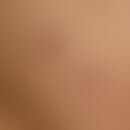Synonym(s)
Panniculitis post-Steroid Panniculitis; Poststeroid panniculitis; Post-Steroid Panniculitis
HistoryThis section has been translated automatically.
Smith & Good, 1956
DefinitionThis section has been translated automatically.
Rare complication after prompt reduction of a high-dose internal corticosteroid treatment. Nodular panniculitis. Occurs 1-35 days after discontinuation.
You might also be interested in
EtiopathogenesisThis section has been translated automatically.
Etiology unknown. The cumulative system dose range for prednisolone administration is between 2.0 and 5.0 g per os or i.v.
ManifestationThis section has been translated automatically.
Mainly occurring in children, usually between the 20th month of life and the 14th year of age. Less frequently also with adults.
LocalizationThis section has been translated automatically.
Mostly located on cheeks, chin, arms or trunk.
ClinicThis section has been translated automatically.
Up to 4 cm large, firm, subcutaneous nodules and plates. The skin is red to skin-coloured. Slight hyperthermia. Occasional slight itching. Usually no other symptoms.
HistologyThis section has been translated automatically.
Lobular panniculitis, with a strong inflammatory response by lymphocytes, macrophages and multinuclear giant cells. Needle-shaped, radially arranged recesses (needle shaved clefts) in the fat cells.
Differential diagnosisThis section has been translated automatically.
TherapyThis section has been translated automatically.
No causal therapy known and necessary. Recovery in weeks to months, therefore a wait-and-see attitude (especially in mild cases) is justifiable.
External therapyThis section has been translated automatically.
Apply non-steroidal anti-inflammatory drugs such as indomethacin (e.g. Amuno gel), ibuprofen (e.g. Dolgit cream) or piroxicam (e.g. Felden-top cream) in a thick layer on lesioned skin, additionally apply hourly compresses with 0.9% saline solution or 2-5% ethanol.
Internal therapyThis section has been translated automatically.
As far as possible, avoid systemic glucocorticoids.
Progression/forecastThis section has been translated automatically.
Favourable: regression in weeks to months.
LiteratureThis section has been translated automatically.
- Llamas-Velasco M et al (2015) Panniculitis with crystals induced by etanerceptsubcutaneous injection. J Cutan Pathol doi: 10.1111/cup.12478
- Marovt M et al (2012) Post-steroid panniculitis in an adult. Acta Dermatovenerol Alp Pannonica Adriat 21:77-78
- Requena L et al (2001) Panniculitis. Part II. Mostly lobular panniculitis. J Am Acad Dermatol 45: 325-361
- Roenigk HH et al (1964) Poststeroid panniculitis. Arch Dermatol 90: 386-391
- Smith RT, Good RA (1956) Sequelae of prednisone treatment of acute rheumatic fever. Clin Res Proc 4: 156-157
- Sacchidanand SA et al.(2013) Post-steroid panniculitis: A rare case report. Indian Dermatol Online J 4:318-320
Outgoing links (4)
Erythema nodosum; Glucocorticosteroids; Panniculitis nodularis nonsuppurativa; Panniculitis (overview);Disclaimer
Please ask your physician for a reliable diagnosis. This website is only meant as a reference.




